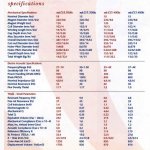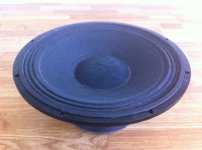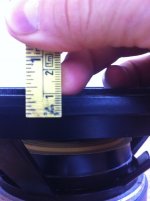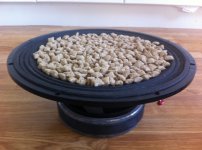Interesting specs, they do not pass cross checking. There appears to be an error in mms and or fs. I would think this is from nominalizing the params for the 4/8/16 ohm versions of the driver. It would be nice to nail these down a bit closer but it's still gonna work out OK.
I guess the only things you would need to measure are the cone volume and the thickness of the front flange of the driver. I was also thinking you could use cereal if you happen to have some of the "kids" type stuff around. Don't forget the milk 😛
I guess the only things you would need to measure are the cone volume and the thickness of the front flange of the driver. I was also thinking you could use cereal if you happen to have some of the "kids" type stuff around. Don't forget the milk 😛
Hehe..wonder how the milk will affect...🙂 I will look for some serials and measure. Do you want it in Litres? Strange regarding the specs...have to be what you say..something to do with the 4/8/16.
Can you illustrate that...not quite sure what you mean?Looking good there, can you measure the the distance from the backplate to the spider landing?
The spider is the yellow part at the bottom of the cone. The distance from the table surface up to the spider is what I'm looking for.
Back chamber and throat plate. You may want to make the horn from something else like fiberglass or paper if you are patient.
Backchamber and throatplate could be a mix of MDF and plywood? I have not thought about this yet. Reccomandations?
All the horns will be made in MDF. The thickness of the walls will probably be 30-40mm...even a little more in the throat perhaps. No fiberglass or paper.
All the horns will be made in MDF. The thickness of the walls will probably be 30-40mm...even a little more in the throat perhaps. No fiberglass or paper.
Use Birch Plywood
for the baffle board (the part to which the driver is mounted); for the rest, MDF is sufficient. Line back box with 1" wool felt for best results.
Regards,
WHG
Backchamber and throatplate could be a mix of MDF and plywood? I have not thought about this yet. Reccomandations?
All the horns will be made in MDF. The thickness of the walls will probably be 30-40mm...even a little more in the throat perhaps. No fiberglass or paper.
for the baffle board (the part to which the driver is mounted); for the rest, MDF is sufficient. Line back box with 1" wool felt for best results.
Regards,
WHG
OK what I really want to know is how thick the material you have access to is. MDF or ply is your choice. Are you going to turn the horns from layers of MDF?
I have access to 19mm, 22mm and 30mm MDF. The 30mm is a little harder to get hold off, due to weight and ultimatly price. Ply, I have access to 18-19mm, 22-23mm, but also quite expensive. The best ones are 19mm and 22mm MDF, and I can double the layer eventually?OK what I really want to know is how thick the material you have access to is. MDF or ply is your choice. Are you going to turn the horns from layers of MDF?
Ply for stiffness I suppose? Will do that.for the baffle board (the part to which the driver is mounted); for the rest, MDF is sufficient. Line back box with 1" wool felt for best results.
Regards,
WHG
I guess tightly connected to the wall, means that the horn will use the wall as a "lenghtening" of the horn itself?
Hi sannax,
Getting the solid radiation angle right means that the horn mouth acoustical impedance loading calculations will be more correct. The Hornresp simulation model takes into account the actual physical length of the horn only. Because of the way that mouth impedance is calculated, there is no need to assume any "virtual extension" due to wall proximity.
Kind regards,
David
Ply for stiffness I suppose? Will do that.
Driver mounting screw holes are close to driver cut-out, so plywood is not as fragile there and accepts t-nuts better. MDF is actually acoustically superior.
Regards,
WHG
Good advice! Care to explain why MDF is acoustically superior? Many people prefer ply because they mean MDF has resonances here in Norway? Interesting 🙂Driver mounting screw holes are close to driver cut-out, so plywood is not as fragile there and accepts t-nuts better. MDF is actually acoustically superior.
Regards,
WHG
MDF vs. Plywood
Dense, consistent composition of non-oriented wood fiber in a resin binder.
Higher internal damping and stiffer than plywood. See
MDF Board FAQ - Tutorial
for details.
All structures have resonances. In the case of loudspeaker enclosures, we raise their frequency by reinforcing panels across their longest span. Also we may pre-stress them as well (same as concrete). Laminar MDF construction, with pre-stressing threaded rods in tension make for an acoustically inert cabinet.
Regards,
WHG
Good advice! Care to explain why MDF is acoustically superior? Many people prefer ply because they mean MDF has resonances here in Norway? Interesting 🙂
Dense, consistent composition of non-oriented wood fiber in a resin binder.
Higher internal damping and stiffer than plywood. See
MDF Board FAQ - Tutorial
for details.
All structures have resonances. In the case of loudspeaker enclosures, we raise their frequency by reinforcing panels across their longest span. Also we may pre-stress them as well (same as concrete). Laminar MDF construction, with pre-stressing threaded rods in tension make for an acoustically inert cabinet.
Regards,
WHG
- Status
- Not open for further replies.
- Home
- Loudspeakers
- Multi-Way
- Hyperbolic mid/upper bass horn



